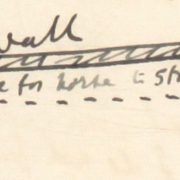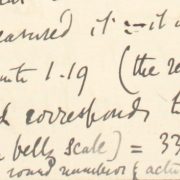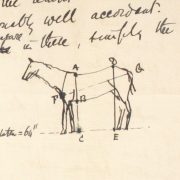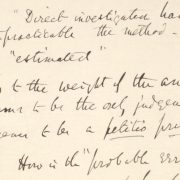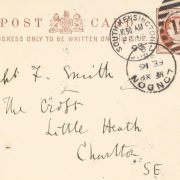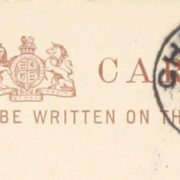5 – Letter to Frederick Smith from Francis Galton, 5 Jan 1898
The copyright of this material belongs to descendants of the creator. Images are permitted for reuse under a Creative Commons, Attribution, Non-commercial license.
Click here for full transcript of letter
[FS/3/3/2/5]
42, Rutland Gate, S.W.
Jan 5/98
Dear Capt Smith
Your two memoirs, which I enclose, interest me much.
Wd not the title of the M S be better
“Relation between the Weight of a horse and his weight-carrying power”?
What you determine in the relation to his estimated weight carrying power & these seemed wanting evidence to show that the estimate concurred with fact. As it stands, you show that
[[2]]
the complex of motives by which experts judge, is on the average in direct ratio to the weight of the horse.
I wd suggest if you wish to submit the paper to the R. Soc to make this clear, and to explain the amount of reliance and of responsibility that is extended to experts.
It would be very interesting to collate the judgements of several experts about the same horse, but that wd be an inquiry by itself.
The following however ought to be done – viz show the mean deviation between the estimated and the calculated values in each
[[3]]
of your 4 groups. Strictly, the ratios of error/weight shd be compared; possibly error (deviation) wd be near enough.
Another thing, in the greater strictness now exercised about the Proceedings, with the view of reducing the bulk of printed matter. I shd therefore suggest (rather strongly) you omitting down to the 2nd method in p. 4, so starting in medias res.
Please let me hesitate about submitting it to the R. Soc untill[sic] I shall have seen it again.
[[4]]
The subject is not strictly in my line so it will be necessary anyhow for me to read it in in the first case, privately & subject to the approved of Michael Foster. If he or his referree[sic] it is all right the paper wd then go in regularly, which wd give me great pleasure. I should be always delighted to do any thing of the kind for you, you having done so much for me.
I was intending to write to you either to-day or to-morrow, because my article on “Measurement of Horses & Photography” comes out in “Nature” to-morrow. You shall
[[5]]
have a copy soon after. It would indeed be a great help to me if I could photograph at the Vet: Hospital. Do not answer till you have seen the article. My drawback is that I have to be very careful about weather. Some recurrence of an old Syrian fever (apparently) has now kept me almost to my bedroom for a week or more & though I am getting right, I am not & shall not be capable
[[6]]
of standing wet & cold like ordinary persons.
A very intelligent nephew of my late wife, Frank Butler who is staying (living) with me & acts as my secretary, would help effectively.
This is the first long letter I have written since my shiverings &c came on.
Very sincerely yours
Francis Galton



